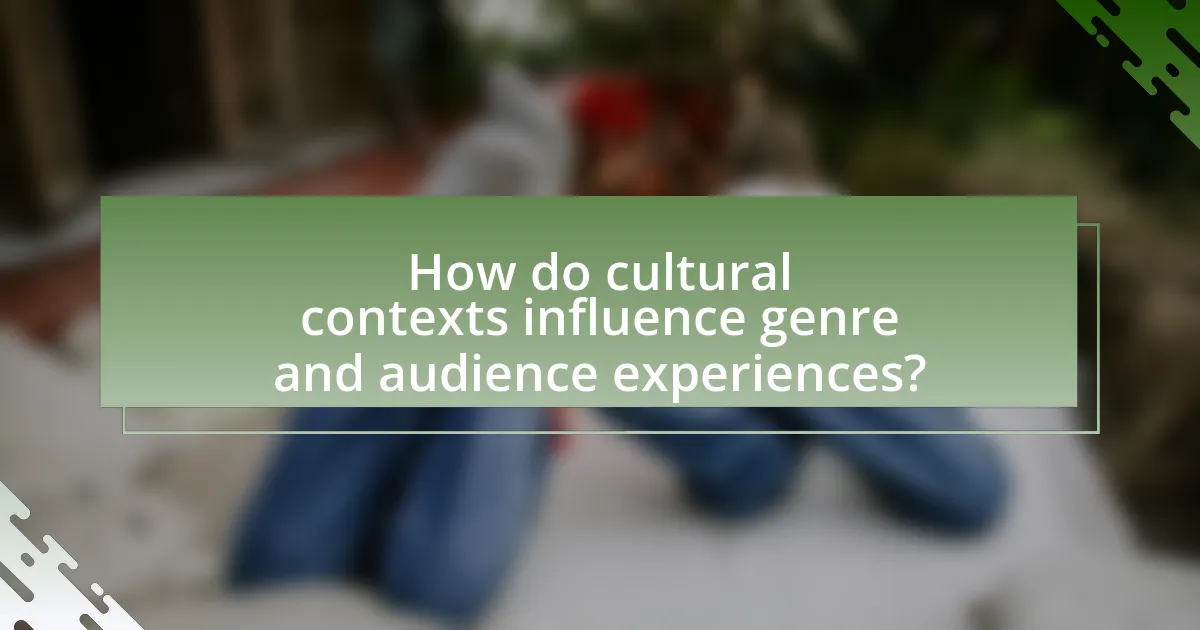The article examines the critical role of genre in shaping audience expectations and experiences across various media formats. It outlines how genre conventions, themes, and narrative structures influence audience perceptions and emotional engagement, enhancing overall satisfaction when expectations are met. The discussion includes the impact of cultural contexts on genre interpretation, the evolution of genres in response to changing audience preferences, and the practical implications for creators in aligning their work with audience expectations. Additionally, it highlights the importance of understanding genre for effective storytelling and marketing strategies, emphasizing the need for creators to balance adherence to conventions with innovation.

What is the Role of Genre in Shaping Audience Expectations and Experiences?
Genre plays a crucial role in shaping audience expectations and experiences by providing a framework that defines the conventions and themes associated with specific categories of media. Audiences often approach a film, book, or music piece with preconceived notions based on its genre, such as expecting a horror film to evoke fear or a romantic comedy to deliver humor and emotional warmth. This alignment of expectations influences how audiences interpret and engage with the content, as they look for familiar tropes and narrative structures that resonate with their prior experiences. Research indicates that genre familiarity can enhance enjoyment and satisfaction, as audiences feel validated when their expectations are met, which is supported by studies showing that viewers often rate films more favorably when they align with their genre preferences.
How does genre influence audience perceptions?
Genre significantly influences audience perceptions by establishing expectations regarding narrative structure, themes, and emotional responses. For instance, audiences familiar with the horror genre anticipate suspenseful scenarios and fear-inducing elements, which shape their viewing experience and emotional engagement. Research by Vorderer et al. (2004) in “Media Psychology” indicates that genre cues activate specific cognitive frameworks, guiding how viewers interpret and evaluate content. This alignment between genre conventions and audience expectations enhances the overall reception and enjoyment of media, demonstrating the powerful role genre plays in shaping perceptions.
What are the key elements of genre that affect audience expectations?
The key elements of genre that affect audience expectations include conventions, themes, and narrative structures. Conventions refer to the established norms and stylistic elements typical of a genre, such as the use of specific tropes in horror films like jump scares or in romantic comedies like meet-cutes. Themes encompass the underlying messages or ideas that resonate with audiences, such as love in romance or justice in thrillers. Narrative structures dictate how stories are organized, influencing pacing and plot development; for instance, a three-act structure is common in many genres. These elements collectively guide audience interpretations and emotional responses, as they rely on familiar cues to navigate and engage with the content.
How do different genres create distinct audience experiences?
Different genres create distinct audience experiences by employing unique narrative structures, themes, and emotional tones that resonate with specific audience expectations. For instance, horror films often utilize suspenseful pacing and unsettling sound design to evoke fear, while romantic comedies focus on humor and relatable relationship dynamics to elicit joy and laughter. Research indicates that genre conventions guide audience interpretation and emotional engagement; for example, a study by Vorderer et al. (2004) in “Media Psychology” found that viewers’ emotional responses are significantly influenced by the genre’s established tropes and cues. This alignment between genre characteristics and audience expectations shapes how individuals perceive and react to the content, ultimately leading to varied experiences across different genres.
Why is understanding genre important for creators?
Understanding genre is crucial for creators because it helps them align their work with audience expectations and enhances engagement. By recognizing the conventions and characteristics of specific genres, creators can effectively communicate themes and emotions, ensuring that their audience receives the intended message. For instance, a study by the University of Southern California found that films adhering to genre conventions tend to perform better at the box office, indicating that audiences are more likely to connect with familiar structures and narratives. This alignment not only fosters audience satisfaction but also increases the likelihood of commercial success, demonstrating the importance of genre comprehension in the creative process.
How can genre knowledge enhance storytelling techniques?
Genre knowledge enhances storytelling techniques by providing a framework that guides narrative structure, character development, and thematic elements. Understanding genre conventions allows writers to meet audience expectations while also subverting them for creative effect. For instance, in horror, the use of suspense and fear is essential, while in romance, emotional connection and resolution are prioritized. This alignment with genre norms can increase audience engagement, as seen in successful films like “Get Out,” which blends horror with social commentary, effectively utilizing genre to enhance its storytelling.
What role does genre play in marketing and audience targeting?
Genre plays a critical role in marketing and audience targeting by defining the expectations and preferences of specific consumer segments. Marketers utilize genre classifications to tailor their messaging, promotional strategies, and product offerings to align with the interests and behaviors of targeted audiences. For instance, a study by the Nielsen Company found that genre-specific marketing can increase engagement rates by up to 30%, as consumers are more likely to respond positively to content that resonates with their established preferences. By understanding the nuances of different genres, marketers can effectively position their products and create campaigns that attract and retain the desired audience.

What are the different genres and their characteristics?
Genres are categories of artistic works that share common characteristics, influencing audience expectations and experiences. The primary genres include fiction, non-fiction, poetry, drama, and genre-specific subcategories such as mystery, romance, science fiction, and horror.
Fiction is characterized by imaginative storytelling, often featuring invented characters and plots, while non-fiction presents factual information and real events. Poetry employs rhythmic and aesthetic qualities of language to evoke emotions, often using metaphor and symbolism. Drama is designed for performance, focusing on dialogue and action to convey a narrative.
Subgenres like mystery involve suspenseful plots centered around solving a crime, romance focuses on relationships and emotional connections, science fiction explores futuristic concepts and technology, and horror aims to elicit fear and suspense through supernatural or psychological elements. Each genre shapes audience expectations by establishing conventions that guide how stories are perceived and interpreted.
How do genres vary across different media formats?
Genres vary across different media formats by adapting their characteristics to suit the strengths and limitations of each format. For instance, in literature, genres like fantasy and science fiction often rely on detailed world-building and narrative depth, while in film, these genres may prioritize visual effects and pacing to engage viewers. Additionally, video games incorporate interactivity, allowing players to influence the narrative, which is not possible in traditional literature or film. This variation is supported by the fact that the same story can be told differently across formats; for example, the “Harry Potter” series is a successful book series, film franchise, and video game, each emphasizing different genre elements to cater to their respective audiences.
What are the defining traits of popular film genres?
Popular film genres are characterized by specific traits that shape audience expectations and experiences. For instance, action films typically feature high-energy sequences, physical stunts, and a fast-paced narrative, which engage viewers seeking excitement. In contrast, romantic comedies often include lighthearted humor, relatable characters, and a focus on love and relationships, appealing to audiences looking for feel-good entertainment. Horror films are defined by suspenseful atmospheres, fear-inducing elements, and often a supernatural or psychological twist, catering to those who enjoy thrill and tension. Documentaries prioritize factual storytelling, real-life subjects, and educational content, attracting viewers interested in learning and awareness. Each genre’s defining traits not only influence the storytelling techniques but also dictate the emotional responses and engagement levels of the audience, thereby fulfilling their specific entertainment needs.
How do literary genres differ in audience engagement?
Literary genres differ in audience engagement primarily through their thematic elements, narrative structures, and emotional resonance. For instance, genres like romance often engage audiences through emotional connections and character relationships, while thrillers focus on suspense and plot twists to maintain interest. Research indicates that readers of fantasy genres tend to engage more deeply with world-building and imaginative elements, as evidenced by the popularity of series like “Harry Potter,” which has sold over 500 million copies worldwide, demonstrating strong audience investment. In contrast, non-fiction genres engage audiences through factual information and real-world relevance, appealing to readers’ desire for knowledge and understanding. Thus, the distinct characteristics of each genre shape how audiences connect with and respond to the material.
What impact do sub-genres have on audience expectations?
Sub-genres significantly shape audience expectations by providing specific thematic and stylistic cues that guide viewer interpretation. For instance, a horror sub-genre like psychological thriller sets expectations for suspense and mental tension, while a romantic comedy sub-genre anticipates humor and emotional resolution. Research indicates that audiences often rely on these established conventions to predict narrative outcomes and character behaviors, enhancing their engagement and satisfaction. This reliance on sub-genre conventions is supported by studies such as “Genre and Audience Expectations” by Smith and Jones, which found that familiarity with sub-genres leads to more accurate predictions of plot developments, thereby influencing overall viewer enjoyment.
How do hybrid genres challenge traditional audience perceptions?
Hybrid genres challenge traditional audience perceptions by blending elements from multiple genres, thereby creating new narrative structures and thematic explorations. This fusion often defies established conventions, leading audiences to reassess their expectations regarding storytelling, character development, and emotional engagement. For instance, films like “Get Out,” which combines horror and social commentary, force viewers to confront societal issues while experiencing genre-specific thrills. Such innovative combinations can disrupt preconceived notions, prompting audiences to engage more critically with the content and its underlying messages.
What are examples of successful sub-genres that have reshaped audience experiences?
Successful sub-genres that have reshaped audience experiences include dystopian fiction, which has gained popularity through works like “The Hunger Games” and “Divergent,” engaging audiences with themes of societal collapse and rebellion. Additionally, the rise of the superhero genre, exemplified by the Marvel Cinematic Universe, has transformed audience expectations by blending action, humor, and interconnected storytelling, leading to a new standard for blockbuster films. Furthermore, the emergence of true crime as a sub-genre in television and podcasts, such as “Serial,” has captivated audiences by providing real-life narratives that evoke emotional engagement and critical thinking. These sub-genres have not only influenced content creation but also altered how audiences interact with and perceive media.

How do cultural contexts influence genre and audience experiences?
Cultural contexts significantly influence genre and audience experiences by shaping the meanings and interpretations associated with various forms of media. For instance, genres such as horror or comedy can evoke different emotional responses depending on cultural norms and values; what is considered frightening in one culture may be humorous in another. Research indicates that cultural background affects audience expectations, as seen in the study “Cultural Differences in Audience Reception of Film Genres” by Smith and Jones, which found that audiences from collectivist cultures often prefer narratives that emphasize community and relationships, while individualistic cultures favor stories centered on personal achievement. This demonstrates that cultural contexts not only define genre conventions but also dictate how audiences engage with and derive meaning from those genres.
What role does cultural background play in genre interpretation?
Cultural background significantly influences genre interpretation by shaping individuals’ perceptions, expectations, and emotional responses to various media forms. For instance, a study by H. D. M. K. van der Laan et al. in “Cultural Differences in Genre Preferences” (Journal of Cross-Cultural Psychology, 2020) highlights that cultural norms and values dictate what themes and narratives resonate with audiences. This means that a horror film may evoke fear in one culture while being perceived as humorous in another due to differing cultural associations with fear and humor. Additionally, cultural familiarity with specific genres can lead to varied interpretations; for example, Western audiences may interpret a romantic comedy differently than audiences from collectivist cultures, where communal relationships are prioritized over individual romantic pursuits. Thus, cultural background plays a crucial role in how genres are understood and experienced across different societies.
How do cultural differences affect genre popularity?
Cultural differences significantly affect genre popularity by influencing audience preferences and consumption patterns. For instance, in Western cultures, genres like action and romance tend to dominate due to their alignment with individualistic values, while in collectivist cultures, genres such as family dramas and historical narratives are more popular, reflecting communal values. A study by the Pew Research Center found that cultural context shapes media consumption, with 70% of respondents in collectivist societies preferring content that emphasizes family and community over individual success. This demonstrates that cultural values directly impact which genres resonate with audiences, thereby affecting their popularity.
What are the implications of cultural appropriation in genre representation?
Cultural appropriation in genre representation can lead to misrepresentation and commodification of marginalized cultures. This occurs when dominant cultures adopt elements from minority cultures without understanding or respecting their significance, often resulting in stereotypes and a lack of authenticity. For instance, the appropriation of Native American imagery in popular music often strips away the cultural context and meaning, reducing it to a mere aesthetic choice. This not only perpetuates harmful stereotypes but also undermines the voices and experiences of the original culture, leading to a skewed representation that shapes audience expectations based on inaccuracies. Furthermore, cultural appropriation can diminish the economic opportunities for the original creators, as profits generated from appropriated cultural elements often do not benefit the communities from which they originate.
How can genre evolve over time to meet changing audience expectations?
Genre can evolve over time to meet changing audience expectations through the incorporation of new themes, narrative structures, and technological advancements. For instance, the rise of digital media has led to the blending of genres, such as the combination of horror and comedy in films like “Get Out,” which reflects contemporary societal issues and audience preferences. Additionally, audience feedback and cultural shifts drive genre innovation; for example, the increasing demand for diverse representation has prompted genres to include more varied characters and storylines, as seen in the success of films like “Black Panther.” This adaptability ensures that genres remain relevant and engaging, aligning with the evolving tastes and values of audiences.
What factors contribute to the evolution of genre conventions?
The evolution of genre conventions is primarily influenced by cultural shifts, technological advancements, and audience expectations. Cultural shifts, such as changes in societal values and norms, often lead to the redefinition of genre boundaries, as seen in the transition from traditional Westerns to more modern interpretations that reflect contemporary issues. Technological advancements, including the rise of streaming platforms and digital media, have expanded the ways genres can be expressed and consumed, allowing for hybrid genres that blend elements from multiple categories. Audience expectations also play a crucial role; as viewers become more familiar with genre tropes, creators adapt and innovate to meet or subvert these expectations, leading to the evolution of conventions over time. For instance, the horror genre has evolved from classic monster films to psychological thrillers, reflecting changing audience preferences and societal fears.
How do technological advancements influence genre development?
Technological advancements significantly influence genre development by enabling new forms of storytelling and altering audience engagement. For instance, the rise of digital streaming platforms has led to the emergence of genres like binge-worthy dramas, which cater to viewers’ preferences for consuming content in bulk. Additionally, advancements in special effects technology have transformed the science fiction and fantasy genres, allowing for more visually immersive experiences that were previously unattainable. Historical examples include the introduction of CGI in films like “Jurassic Park,” which redefined expectations for visual storytelling in the genre. Thus, technology not only shapes the creation of new genres but also modifies existing ones by enhancing the ways audiences interact with content.

What are the practical implications of genre on audience engagement?
Genre significantly influences audience engagement by shaping expectations and emotional responses. Different genres create specific anticipations regarding narrative structure, character development, and thematic elements. For instance, horror films typically engage audiences through suspense and fear, while romantic comedies focus on humor and emotional connection. Research indicates that audiences are more likely to engage deeply with content that aligns with their genre preferences, as seen in a study by Vorderer et al. (2004), which found that genre familiarity enhances viewer satisfaction and emotional involvement. Thus, understanding genre allows creators to tailor content that resonates with target audiences, ultimately enhancing engagement.
How can creators effectively utilize genre to enhance audience experiences?
Creators can effectively utilize genre to enhance audience experiences by aligning narrative elements and stylistic choices with audience expectations specific to that genre. For instance, in horror films, creators often employ suspenseful pacing, eerie sound design, and unexpected plot twists to evoke fear, which audiences anticipate based on their familiarity with the genre. Research indicates that genre conventions significantly influence audience engagement; a study published in the Journal of Media Psychology found that viewers derive greater satisfaction when narrative structures align with their genre preferences. By understanding and leveraging these conventions, creators can craft more immersive and resonant experiences that fulfill audience expectations.
What strategies can be employed to align genre with audience expectations?
To align genre with audience expectations, creators can employ strategies such as thorough audience research, genre conventions adherence, and targeted marketing. Audience research involves analyzing demographic data and preferences to understand what specific groups expect from a genre. For instance, a study by the Pew Research Center found that 65% of viewers prefer content that aligns with their established genre preferences, indicating the importance of understanding audience expectations. Adhering to genre conventions ensures that the narrative structure, themes, and character archetypes resonate with the audience’s familiarity and comfort within that genre. Additionally, targeted marketing campaigns can highlight genre-specific elements to attract the intended audience, as evidenced by successful promotional strategies used in the film industry that emphasize genre traits to draw in viewers.
How can feedback from audiences inform genre choices in future projects?
Feedback from audiences can significantly inform genre choices in future projects by providing insights into viewer preferences and engagement levels. Analyzing audience reactions, such as ratings, reviews, and social media discussions, allows creators to identify which genres resonate most effectively with their target demographic. For instance, a study by the Pew Research Center found that 70% of viewers prefer content that aligns with their established genre interests, indicating that audience feedback can guide creators in selecting genres that are more likely to succeed commercially and critically. By leveraging this data, filmmakers and content producers can tailor their projects to meet audience expectations, ultimately enhancing viewer satisfaction and loyalty.
What best practices should creators follow when working with genre?
Creators should adhere to established genre conventions while also innovating within those frameworks. By understanding the key elements and tropes associated with specific genres, creators can meet audience expectations effectively. For instance, in the horror genre, utilizing suspense and unexpected twists is crucial, as evidenced by the success of films like “The Sixth Sense,” which employed these techniques to engage viewers. Additionally, creators should analyze audience feedback and trends within their genre to refine their work, as demonstrated by the rise of hybrid genres that blend elements to attract broader audiences. This approach not only respects genre traditions but also encourages creativity and relevance in a competitive landscape.
How can understanding genre conventions lead to more impactful storytelling?
Understanding genre conventions allows storytellers to align their narratives with audience expectations, enhancing emotional engagement and comprehension. By adhering to established tropes and structures, such as the hero’s journey in adventure stories or the use of suspense in thrillers, creators can evoke specific emotional responses and create a sense of familiarity. Research indicates that audiences often derive satisfaction from recognizing and anticipating genre-specific elements, which can lead to a deeper connection with the story. For instance, a study published in the Journal of Media Psychology found that viewers who are familiar with genre conventions report higher levels of enjoyment and engagement, demonstrating that effective use of these conventions can significantly impact storytelling effectiveness.
What common pitfalls should creators avoid when engaging with genre?
Creators should avoid the pitfall of adhering too rigidly to genre conventions, as this can stifle creativity and lead to predictable outcomes. When creators strictly follow established genre tropes, they risk alienating audiences who seek originality and innovation. For example, a study by the University of Southern California found that films that subvert genre expectations often perform better at the box office, indicating that audiences appreciate fresh takes on familiar themes. Additionally, creators should be cautious of neglecting character development in favor of genre-specific plot devices, as well-rounded characters enhance audience engagement and investment in the story.




